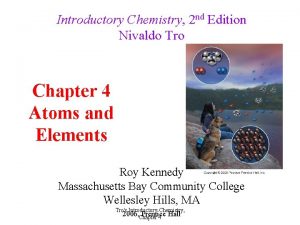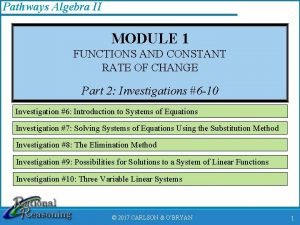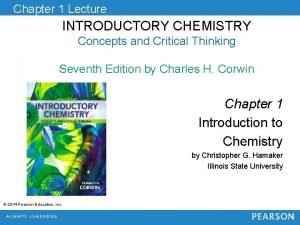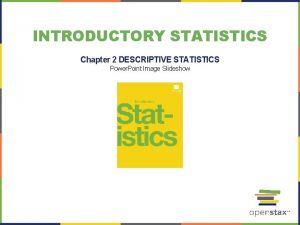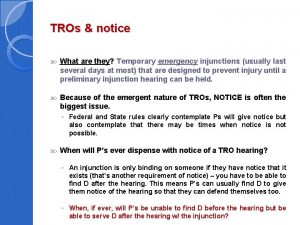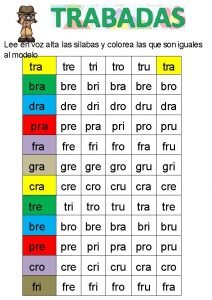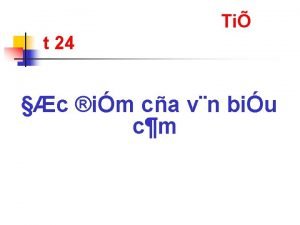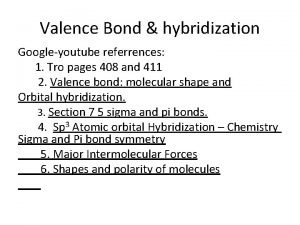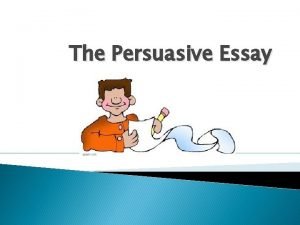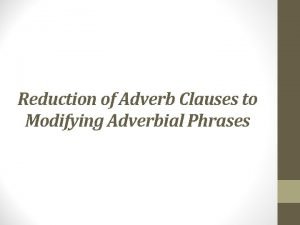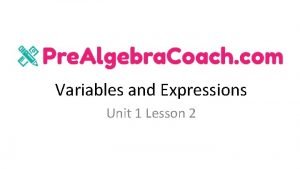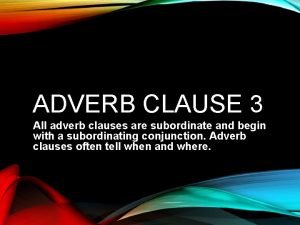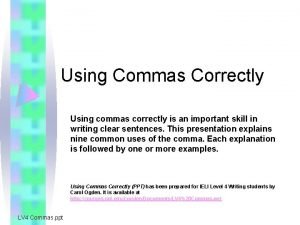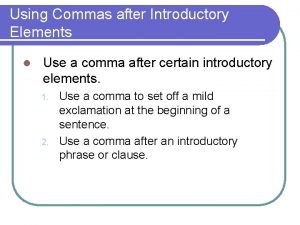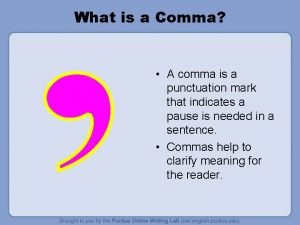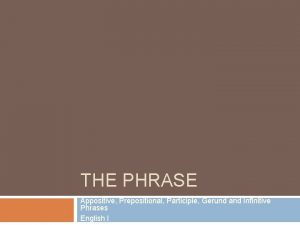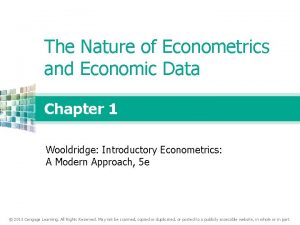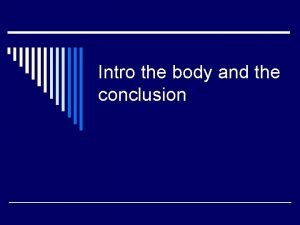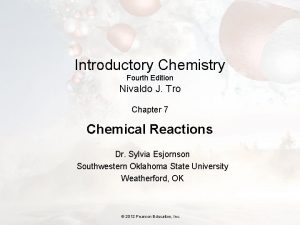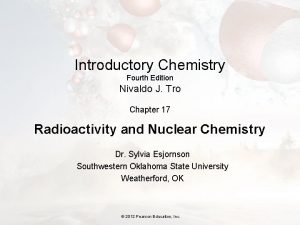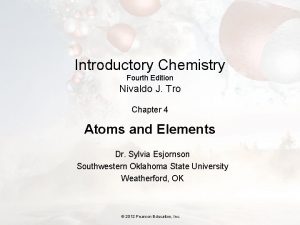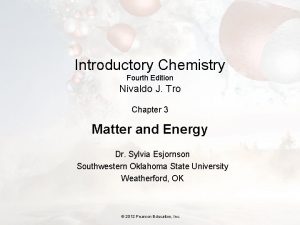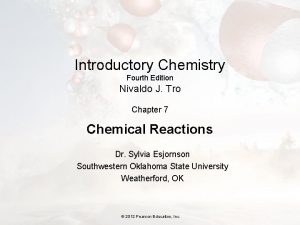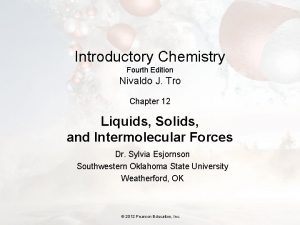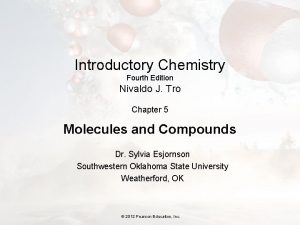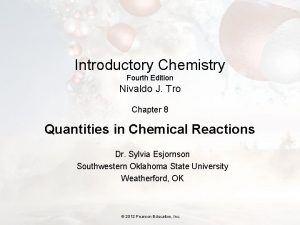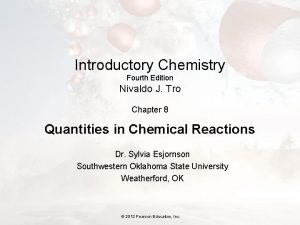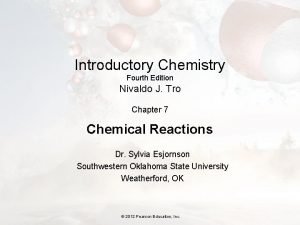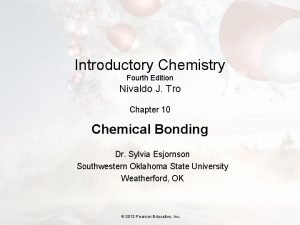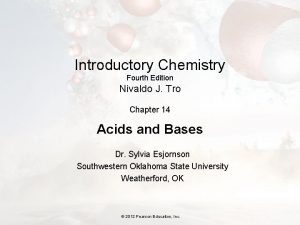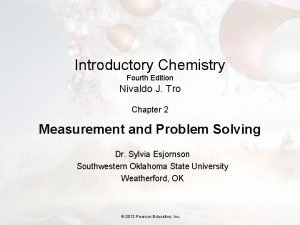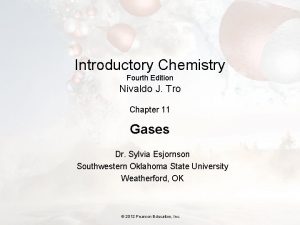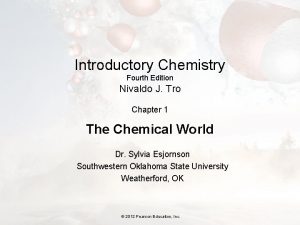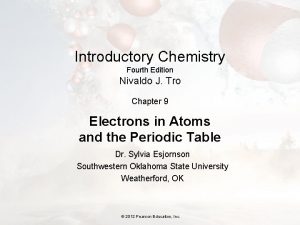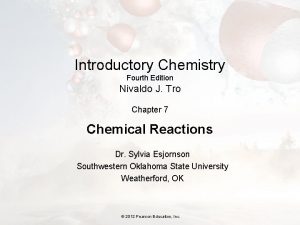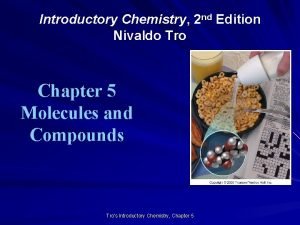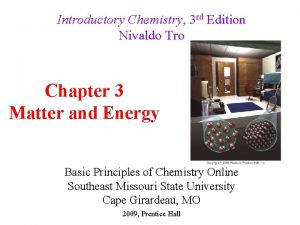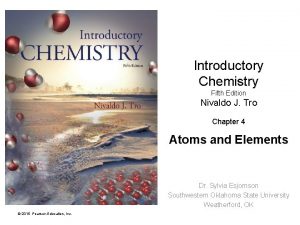Introductory Chemistry Fourth Edition Nivaldo J Tro Chapter
































































































- Slides: 96

Introductory Chemistry Fourth Edition Nivaldo J. Tro Chapter 9 Electrons in Atoms and the Periodic Table Dr. Sylvia Esjornson Southwestern Oklahoma State University Weatherford, OK © 2012 Pearson Education, Inc.

9. 1 Blimps, Balloons, and Models of the Atom • On May 6, 1937, while landing in New Jersey on its first transatlantic crossing, the Hindenburg burst into flames, destroying the airship and killing 36 of the 97 passengers. • Apparently, as the Hindenburg was landing, leaking hydrogen gas ignited, resulting in an explosion that destroyed the airship. • The skin of the Hindenburg, which was constructed of a flammable material, may have also been partially to blame for its demise. The Hindenburg was filled with hydrogen, a reactive and flammable gas. Question: What makes hydrogen reactive? © 2012 Pearson Education, Inc.

9. 1 Blimps, Balloons, and Models of the Atom • Modern blimps are filled with helium, an inert gas. • The nucleus of the helium atom has two protons, so the neutral helium atom has two electrons—a highly stable configuration. • In this chapter we learn about models that explain the inertness of helium and the reactivity of other elements. © 2012 Pearson Education, Inc. Why is helium inert?

9. 1 Blimps, Balloons, and Models of the Atom • What is it about helium atoms that makes helium gas inert? • By contrast, why is hydrogen so reactive? • Elemental hydrogen exists as a diatomic element. • Hydrogen atoms are so reactive that they react with each other to form hydrogen molecules. • What is it about hydrogen atoms that make them so reactive? © 2012 Pearson Education, Inc.

• Are other elements as reactive as hydrogen? • The reactivity exhibited by hydrogen is also seen in other Group I elements, such as lithium and sodium. • The inertness of helium is seen in neon, argon, and the other noble gases. • Mendeleev’s periodic law sums up these observations: When the elements are arranged in order of increasing atomic number, certain sets of properties recur periodically. • Models and theories help explain the observed behaviors of groups of elements such as the Group I metals and noble gases. © 2012 Pearson Education, Inc.

Electrons in Atoms and the Periodic Table • We examine two important models—the Bohr model and the quantum-mechanical model—that propose explanations for the inertness of helium, the reactivity of hydrogen, and the periodic law. • These models explain how electrons exist in atoms and how those electrons affect the chemical and physical properties of elements. © 2012 Pearson Education, Inc.

Niels Bohr (left) and Erwin Schrödinger (right), along with Albert Einstein, played a role in the development of quantum mechanics, yet they were bewildered by their own theory of wave-particle duality for the electron. © 2012 Pearson Education, Inc.

9. 2 Light: Electromagnetic Radiation The interaction of light with atoms helped to shape scientists’ models of the atom. Light is a form of electromagnetic radiation. Light is a type of energy that travels through space at a constant speed of 3. 0 x 108 m/s (186, 000 mi/s). Light has properties of both waves and particles. © 2012 Pearson Education, Inc.

9. 2 Light: Electromagnetic Radiation When a water surface is disturbed, waves are created that radiate outward from the site. The wave carries energy as it moves through the water. © 2012 Pearson Education, Inc.

9. 2 Light: Electromagnetic Radiation • Wavelength: The wavelength of light, λ (lambda, pronounced “lam-duh”), is defined as the distance between adjacent wave crests. © 2012 Pearson Education, Inc.

9. 2 Light: Color of Light • White light, as produced by the sun or by a lightbulb, contains a spectrum of wavelengths and therefore a spectrum of color. • We see these colors—red, orange, yellow, green, blue, indigo, and violet—in a rainbow or when white light is passed through a prism. • Red light, with a wavelength of 750 nm (nanometers), has the longest wavelength of visible light. • Violet light, with a wavelength of 400 nm, has the shortest wavelength of visible light (1 nm = 1 x 10 -9 m). • The presence of color in white light is responsible for the colors we see in our everyday vision. © 2012 Pearson Education, Inc.

9. 2 Light: Color of Light Components of white light ROYGBIV • Light is separated into its constituent colors—red, orange, yellow, green, blue, indigo, and violet —when it is passed through a prism. © 2012 Pearson Education, Inc.

9. 2 Light: Color in Objects • A red shirt appears red because it reflects red light; the shirt absorbs all of the other colors of light except the red light. Our eyes see only the reflected light, making the shirt appear red. © 2012 Pearson Education, Inc.

9. 2 Light: Electromagnetic Radiation • Frequency: The frequency of light, ν (nu, pronounced “noo”), is defined as the number of cycles or crests that pass through a stationary point in one second. • Wavelength and frequency are inversely related—the shorter the wavelength, the higher the frequency. © 2012 Pearson Education, Inc.

9. 2 Light: Electromagnetic Radiation (Photons–Particles of Light) • Light can be viewed as a stream of particles. • A particle of light is called a photon. • We can think of a photon as a single packet of light energy. • The amount of energy carried in the packet depends on the wavelength of the light—the shorter the wavelength, the greater the energy. • Light waves carry more energy if their crests are closer together (higher frequency and shorter wavelength). • Violet light (shorter wavelength) carries more energy per photon than red light (longer wavelength). © 2012 Pearson Education, Inc.

9. 2 Light: Electromagnetic Radiation To summarize: • Electromagnetic radiation is a form of energy that travels through space at a constant speed of 3. 0 x 108 m/s (186, 000 mi/s) and can exhibit wavelike or particle-like properties. • The wavelength of electromagnetic radiation determines the amount of energy carried by one of its photons. The shorter the wavelength, the greater the energy of each photon. • The frequency and energy of electromagnetic radiation are inversely related to its wavelength. © 2012 Pearson Education, Inc.

9. 3 The Electromagnetic Spectrum • The entire electromagnetic spectrum, with shortwavelength, high-frequency radiation on the right and long-wavelength, low-frequency radiation on the left. Visible light is the small sliver in the middle. © 2012 Pearson Education, Inc.

9. 3 The Electromagnetic Spectrum • The shortest wavelength and most energetic photons are those of gamma rays. • Gamma rays are produced by the sun, by stars, and by certain unstable atomic nuclei on Earth. • Excessive human exposure to gamma rays is dangerous because the high energy of gamma-ray photons can damage biological molecules. © 2012 Pearson Education, Inc.

9. 3 The Electromagnetic Spectrum • Next on the electromagnetic spectrum, with longer wavelengths and lower energy than gamma rays, are X-rays, familiar to us from their medical use. • X-rays pass through many substances that block visible light and are used to image internal bones and organs. • Like gamma-ray photons, X-ray photons carry enough energy to damage biological molecules. • While several yearly exposures to X-rays are relatively harmless, excessive exposure to X-rays increases cancer risk. © 2012 Pearson Education, Inc.

9. 3 The Electromagnetic Spectrum • Between X-rays and visible light in the electromagnetic spectrum is ultraviolet or UV light, familiar to us as the component of sunlight that produces a sunburn or suntan. • While not as energetic as gamma-ray or Xray photons, ultraviolet photons still carry enough energy to damage biological molecules. • Excessive exposure to ultraviolet light increases the risk of skin cancer and cataracts and causes premature wrinkling of the skin. © 2012 Pearson Education, Inc.

9. 3 The Electromagnetic Spectrum • Next on the spectrum is visible light, ranging from violet (shorter wavelength, higher energy) to red (longer wavelength, lower energy). • Photons of visible light do not damage biological molecules. • Photons of visible light do cause molecules in our eyes to rearrange, which sends a signal to our brains that results in vision. © 2012 Pearson Education, Inc.

9. 3 The Electromagnetic Spectrum • Infrared light is next, with even longer wavelengths than visible light. • The heat you feel when you place your hand near a hot object is infrared light. • All warm objects, including human bodies, emit infrared light. • While infrared light is invisible to our eyes, infrared sensors can detect it and are often used in nightvision technology to “see” in the dark. • In the infrared region of the spectrum, warm objects—such as human bodies—glow, much as a lightbulb glows in the visible region of the spectrum. © 2012 Pearson Education, Inc.

In the infrared photograph, the warmest areas appear as red and the coolest as dark blue. (Note that the photo confirms the familiar idea that healthy dogs have cold noses. ) (Source Sierra Pacific Innovations. All rights reserved. SPI CORP, www. x 20. org ) © 2012 Pearson Education, Inc.

9. 3 The Electromagnetic Spectrum • Beyond infrared light, at longer wavelengths still, are microwaves, used for radar and in microwave ovens. • Microwave light has longer wavelengths—and therefore lower energy per photon—than visible or infrared light. • Microwave light is efficiently absorbed by water and can heat substances that contain water. • Substances that contain water, such as food, are warmed by the radiation of a microwave oven, but substances that do not contain water, such as a plate, are not. • Some types of dishes contain substances that absorb microwave radiation, but most do not. © 2012 Pearson Education, Inc.

9. 3 The Electromagnetic Spectrum • The longest wavelengths of light are radio waves, which are used to transmit the signals used by AM and FM radio, cellular telephones, television, and other forms of communication. © 2012 Pearson Education, Inc.

EXAMPLE 9. 1 Wavelength, Energy, and Frequency • Arrange three types of electromagnetic radiation —visible light, X-rays, and microwaves— in order of increasing: (a) wavelength (b) frequency (c) energy per photon © 2012 Pearson Education, Inc.

Chemistry and Health Radiation Treatment for Cancer • X-rays and gamma rays are sometimes called ionizing radiation because the high energy in their photons can ionize atoms and molecules. • When ionizing radiation interacts with biological molecules, it can permanently change or even destroy them. • Doctors can use ionizing radiation to destroy molecules within unwanted cells such as cancer cells. © 2012 Pearson Education, Inc.

Chemistry and Health Radiation Treatment for Cancer • • In radiation therapy, doctors aim X -ray or gamma-ray beams at cancerous tumors. The ionizing radiation damages the molecules within the tumor’s cells that carry genetic information, and the cell dies or stops dividing. Healthy cells often inadvertently sustain damage during treatments, resulting in side effects such as fatigue, skin lesions, and hair loss. Doctors try to minimize the exposure of healthy cells by appropriate shielding and by targeting the tumor from multiple directions, minimizing the exposure of healthy cells while maximizing the exposure of cancerous cells. © 2012 Pearson Education, Inc.

Each Element Has Its Own Atomic Emission Spectrum of Light • Neon atoms inside a glass tube absorb electrical energy and then re-emit the energy as light. © 2012 Pearson Education, Inc.

Each Element Has Its Own Atomic Emission Spectrum of Light • Light emitted from a mercury lamp (left) appears blue, and light emitted from a hydrogen lamp (right) appears pink. © 2012 Pearson Education, Inc.

A white-light spectrum is continuous, with some radiation emitted at every wavelength. The emission spectrum of an individual element includes only certain specific wavelengths. © 2012 Pearson Education, Inc.

Light emitted by hydrogen contains distinct wavelengths that are specific to hydrogen. © 2012 Pearson Education, Inc.

Niels Bohr developed a simple model to explain these results. © 2012 Pearson Education, Inc.

The energy of each Bohr orbit, specified by a quantum number n = 1, 2, 3 is fixed, or quantized. Bohr orbits are like steps of a ladder, each at a specific distance from the nucleus and each at a specific energy. It is impossible for an electron to exist between orbits in the Bohr model. © 2012 Pearson Education, Inc.

Excitation and Emission • When a hydrogen atom absorbs energy, an electron is excited to a higher-energy orbit. The electron then relaxes back to a lower-energy orbit, emitting a photon of light. © 2012 Pearson Education, Inc.

Hydrogen emission lines • Since the amount of energy in a photon is directly related to its wavelength, the photon has a specific wavelength. • The light emitted by excited atoms consists of specific lines at specific wavelengths, each corresponding to a specific transition between two orbits. • For example, the line at 486 nm in the hydrogen emission spectrum corresponds to an electron relaxing from the n = 4 orbit to the n = 2 orbit. • In the same way, the line at 657 nm (longer wavelength and lower energy) corresponds to an electron relaxing from the n = 3 orbit to the n = 2 orbit. © 2012 Pearson Education, Inc.

Hydrogen emission lines © 2012 Pearson Education, Inc.

9. 4 The Bohr Model: Atoms with Orbits • The great success of the Bohr model of the atom was that it predicted the lines of the hydrogen emission spectrum. • However, it failed to predict the emission spectra of other elements that contained more than one electron. • For this and other reasons, the Bohr model was replaced with a more sophisticated model called the quantum-mechanical or wave-mechanical model. © 2012 Pearson Education, Inc.

9. 5 The Quantum-Mechanical Model: Atoms with Orbitals • The quantum-mechanical model of the atom replaced the Bohr model in the early twentieth century. In the quantummechanical model Bohr orbits are replaced with quantum-mechanical orbitals. • Orbitals are different from orbits in that they represent probability maps that show a statistical distribution of where the electron is likely to be found. © 2012 Pearson Education, Inc.

9. 5 The Quantum-Mechanical Model: Atoms with Orbitals • Quantum mechanics revolutionized physics and chemistry because, in the quantummechanical model, electrons do not behave like particles flying through space. • We cannot, in general, describe their exact paths. • An orbital is a probability map that shows where the electron is likely to be found when the atom is probed; it does not represent the exact path that an electron takes as it travels through space. © 2012 Pearson Education, Inc.

Baseball Paths and Electron Probability Maps • Contrast the behavior of a baseball with that of an electron. • Imagine a baseball thrown from the pitcher’s mound to a catcher at home plate. • The baseball’s path can easily be traced as it travels from the pitcher to the catcher. © 2012 Pearson Education, Inc.

Baseball Paths and Electron Probability Maps • In the quantum-mechanical world of the electron, the catcher could not know exactly where the electron would cross the plate for any given throw. • He would have no way of putting his mitt in the right place to catch it. • However, if the catcher kept track of hundreds of electron throws, he could observe a reproducible, statistical pattern of where the electron crosses the plate. • He could even draw maps in the strike zone showing the probability of an electron crossing a certain area. These maps are called probability maps. © 2012 Pearson Education, Inc.

Baseball Paths and Electron Probability Maps • To describe the behavior of a “pitched” electron, you would have to construct a probability map of where it would cross home plate. © 2012 Pearson Education, Inc.

9. 6 Quantum-Mechanical Orbitals • In the quantum-mechanical model, a number and a letter specify an orbital (or orbitals). • The lowest-energy orbital in the quantummechanical model is called the 1 s orbital. • It is specified by the number 1 and the letter s. • The number is called the principal quantum number (n) and specifies the principal shell of the orbital. © 2012 Pearson Education, Inc.

Ground States and Excited States • The single electron of an undisturbed hydrogen atom at room temperature is in the 1 s orbital. • This is called the ground state, or lowest energy state, of the hydrogen atom. • The absorption of energy by a hydrogen atom can cause the electron to jump (or make a transition) from the 1 s orbital to a higher-energy orbital. When the electron is in a higher-energy orbital, the hydrogen atom is said to be in an excited state. • All the atoms of each element have one ground state and many excited states. © 2012 Pearson Education, Inc.

9. 6 Quantum-Mechanical Orbitals • The higher the principal quantum number, the higher the energy of the orbital. • The possible principal quantum numbers are n = 1, 2, 3 … with energy increasing as n increases. • Since the 1 s orbital has the lowest possible principal quantum number, it is in the lowest-energy shell and has the lowest possible energy. © 2012 Pearson Education, Inc.

9. 6 Quantum-Mechanical Orbitals • The letter indicates the subshell of the orbital and specifies its shape. • The possible letters are s, p, d, and f, each with a different shape. • Orbitals within the s subshell have a spherical shape. © 2012 Pearson Education, Inc.

Representations of Orbitals • Orbitals are sometimes represented by dots, where the dot density is proportional to the probability of finding the electron. • The dot density for the 1 s orbital is greatest near the nucleus and decreases farther away from the nucleus. • The electron is more likely to be found close to the nucleus than far away from it. © 2012 Pearson Education, Inc.

• Orbitals can be represented as geometric shapes that encompass most of the volume where the electron is likely to be found. • The 1 s orbital can be represented as a sphere that encompasses the volume within which the electron is found 90% of the time. • If we superimpose the dot representation of the 1 s orbital on the shape representation, we can see that most of the dots are within the sphere, meaning that the electron is most likely to be found within the sphere when it is in the 1 s orbital. © 2012 Pearson Education, Inc.

Dot density and shape representations of the 1 s orbital: The dot density is proportional to the probability of finding the electron. The greater dot density near the middle represents a higher probability of finding the electron near the nucleus. © 2012 Pearson Education, Inc.

The number of subshells in a given principal shell is equal to the value of n. © 2012 Pearson Education, Inc.

The 2 s orbital is similar to the 1 s orbital, but larger in size. © 2012 Pearson Education, Inc.

The 2 p orbitals: This figure shows both the dot representation (left) and shape representation (right) for each p orbital. © 2012 Pearson Education, Inc.

Orbitals When n = 3 • The next principal shell, n = 3, contains three subshells specified by s, p, and d. • The s and p subshells contain the 3 s and 3 p orbitals, similar in shape to the 2 s and 2 p orbitals, but slightly larger and higher in energy. • The d subshell contains five d orbitals. © 2012 Pearson Education, Inc.

The 3 d orbitals: This figure shows both the dot representation (left) and shape representation (right) for each d orbital. © 2012 Pearson Education, Inc.

From Orbits to Orbitals • The quantum-mechanical model predicts the bright-line spectrum of hydrogen as well as the Bohr model does. • The quantum-mechanical model can predict the brightline spectra of other elements; the Bohr model cannot predict spectra for atoms with more than one electron. • The Bohr model was replaced with a more sophisticated model called the quantum-mechanical or wave-mechanical model. • The Bohr model is still important because it provides a logical foundation to the quantum-mechanical model and reveals the historical development of scientific understanding. © 2012 Pearson Education, Inc.

Electron Configurations: How Electrons Occupy Orbitals • An electron configuration shows the occupation of orbitals by electrons for a particular atom. • The electron configuration for a ground-state hydrogen atom is: • The electron configuration tells us that hydrogen’s single electron is in the 1 s orbital. © 2012 Pearson Education, Inc.

Electron Configurations: Orbital Diagrams • Another way to represent this information is with an orbital diagram, which gives similar information but shows the electrons as arrows in a box representing the orbital. • The orbital diagram for a ground-state hydrogen atom is: • The box represents the 1 s orbital, and the arrow within the box represents the electron in the 1 s orbital. © 2012 Pearson Education, Inc.

Electron Spin • In orbital diagrams, the direction of the arrow (pointing up or pointing down) represents electron spin, a fundamental property of electrons. • The Pauli exclusion principle states that orbitals may hold no more than two electrons with opposing spins. • We symbolize this as two arrows pointing in opposite directions. © 2012 Pearson Education, Inc.

Energy ordering of orbitals for multi-electron atoms • In multi-electron atoms, the subshells within a principal shell do not have the same energy because of electron–electron interactions. • Different subshells within the same principal shell have different energies. • The 4 s subshell is lower in energy than the 3 d subshell, even though its principal quantum number is higher. © 2012 Pearson Education, Inc.

Energy ordering of orbitals for multi-electron atoms © 2012 Pearson Education, Inc.

• A helium atom has two electrons. • The electron configuration and orbital diagram for helium are: • A lithium atom has three electrons. • The electron configuration and orbital diagram for lithium are: © 2012 Pearson Education, Inc.

For carbon, which has six electrons, the electron configuration and orbital diagram are: • The 2 p electrons occupy the p orbitals (of equal energy) singly, rather than pairing in one orbital. This is the result of Hund’s rule: • When filling orbitals of equal energy, electrons fill them singly first, with parallel spins. © 2012 Pearson Education, Inc.

Orbitals fill in the following order: 1 s 2 s 2 p 3 s 3 p 4 s 3 d 4 p 5 s 4 d 5 p 6 s. © 2012 Pearson Education, Inc.

To write electron configurations: • Lower-energy orbitals fill before higherenergy orbitals. • Orbitals can hold no more than two electrons each. When two electrons occupy the same orbital, they must have opposing spins. This is known as the Pauli exclusion principle. • When orbitals of identical energy are available, all of these are first occupied singly by electrons with parallel spins rather than electrons in pairs. This is known as Hund’s rule. © 2012 Pearson Education, Inc.

• Start with “N(7) …go to Ne(10)” The electron configuration of neon represents the complete filling of the n = 2 principal shell. © 2012 Pearson Education, Inc.

The noble gas core notation: • When writing electron configurations for elements beyond neon—or beyond any other noble gas—the electron configuration of the previous noble gas can be abbreviated by the symbol for the noble gas in brackets. • For sodium (11) Na: 1 s 22 p 63 s 1 Na: [Ne]3 s 1 © 2012 Pearson Education, Inc.

9. 7 Electron Configurations and the Periodic Table • Valence electrons are the electrons in the outermost principal shell (the principal shell with the highest principal quantum number, n). • These electrons are important because they are involved in chemical bonding. • Electrons that are not in the outermost principal shell are called core electrons. © 2012 Pearson Education, Inc.

Valence Electrons and Core Electrons Silicon has 4 valence electrons (those in the n = 3 principal shell) and 10 core electrons. © 2012 Pearson Education, Inc.

Valence Electrons and Core Electrons Selenium has 6 valence electrons (those in the n = 4 principal shell). All other electrons, including those in the 3 d orbitals, are core electrons. © 2012 Pearson Education, Inc.

The elements within a column of the periodic table all have the same number of valence electrons and similar outer electron configurations. © 2012 Pearson Education, Inc.

A pattern exists for the entire periodic table. • The first two columns on the left side of the periodic table are the s block. • The six columns on the right side of the periodic table are the p block. • The transition metals are the d block. • The lanthanides and actinides (also called the inner transition metals) are the f block. © 2012 Pearson Education, Inc.

© 2012 Pearson Education, Inc.

Periodic Trends in Electron Configurations of the Main Group Elements • The number of valence electrons for any maingroup element is equal to the group number of its column. (Helium is an exception. ) • Chlorine has 7 valence electrons because it is in the column with group number 7 A. • The row number in the periodic table is equal to the number of the highest principal shell (n value). • Chlorine is in row 3; its highest principal shell is the n = 3 shell. • Remember that main-group elements are those in the two far left columns (1 A, 2 A) and the six far right columns (3 A– 8 A) of the periodic table. © 2012 Pearson Education, Inc.

Periodic Trends in Electron Configurations of the Transition Series Elements • The transition metals have electron configurations with trends that differ somewhat from main-group elements. • The principal quantum number of the d orbital being filled across each row in the transition series is equal to the row number minus one. • For the first transition series, the outer configuration is 4 s 23 dx (x = number of d electrons). • Two exceptions: Cr is is 4 s 13 d 5 and Cu is is 4 s 13 d 10. • These exceptions occur because a half-filled d subshell and a completely filled d subshell are particularly stable. © 2012 Pearson Education, Inc.

Periodic Trends in Electron Configurations of the Transition Series Elements • The number of outer-shell electrons in a transition series does not change as you move across a period. • The transition series represents the filling of core orbitals and the number of outershell electrons is mostly constant– either 2 or 1. (2 e-) for 4 s 23 dx (1 e-) for 4 s 13 d 5 or 4 s 13 d 10 © 2012 Pearson Education, Inc.

Write the electron configuration for an element based on its position in the periodic table: phosphorus © 2012 Pearson Education, Inc.

Write the electron configuration for any element based on its position in the periodic table. • The inner electron configuration is the electron configuration of the noble gas that immediately precedes that element in the periodic table. Represent the inner configuration with the symbol for the noble gas in brackets. • The outer electrons can be determined from the element’s position within a particular block (s, p, d, or f) in the periodic table. Trace the elements between the preceding noble gas and the element of interest, and assign electrons to the appropriate orbitals. • The highest principal quantum number (highest n value) is equal to the row number of the element in the periodic table. • For any element containing d electrons, the principal quantum number (n value) of the outermost d electrons is equal to the row number of the element minus 1. © 2012 Pearson Education, Inc.

9. 8 The Explanatory Power of the Quantum-Mechanical Model Some observations: • Sodium tends to form Na+ ions, and fluorine tends to form F− ions. • Some elements are metals, and others are nonmetals. • The noble gases are chemically inert, and the alkali metals are chemically reactive. © 2012 Pearson Education, Inc.

9. 8 The Explanatory Power of the Quantum-Mechanical Model • The chemical properties of elements are largely determined by the number of valence electrons they contain. • Their properties vary in a periodic fashion because the number of valence electrons is periodic. © 2012 Pearson Education, Inc.

• Calculations show that atoms with 8 valence electrons (or 2 for helium) are predicted to be particularly low in energy and therefore stable. • The noble gases are chemically stable, and thus relatively inert or nonreactive as accounted for by the quantum model. • Elements with electron configurations close to the noble gases are the most reactive because they can attain noble gas electron configurations by losing or gaining a small number of electrons. © 2012 Pearson Education, Inc.

• Alkali metals (Group 1) are among the most reactive metals since their outer electron configuration (ns 1) is 1 electron beyond a noble gas configuration. • If they can react to lose the electron, they attain a noble gas configuration. • This explains why the Group 1 metals tend to form 1+ cations. © 2012 Pearson Education, Inc.

• The alkaline earth metals (Group 2) all have electron configurations ns 2 and are therefore 2 electrons beyond a noble gas configuration. • In their reactions, they tend to lose 2 electrons, forming 2+ ions and attaining a noble gas configuration. © 2012 Pearson Education, Inc.

• The halogens (Group 7) all have ns 2 np 5 electron configurations and are therefore 1 electron short of a noble gas configuration. • In their reactions, halogens tend to gain 1 electron, forming 1− ions and attaining a noble gas configuration. © 2012 Pearson Education, Inc.

Elements that form predictable ions © 2012 Pearson Education, Inc.

Periodic Trends: Atomic Size Has Two Factors • #1: As you move to the right across a period in the periodic table, atomic size decreases. • The atomic size of an atom is determined by the distance between the outermost electrons and the nucleus. • The size of an orbital depends on the principal quantum number. • With each step across a period, the number of protons in the nucleus is increasing. • This increase in the number of protons results in a greater pull on the electrons from the nucleus, causing atomic size to decrease. © 2012 Pearson Education, Inc.

Periodic Trends: Atomic Size Has Two Factors • #2: As you move down a column in the periodic table, atomic size increases. • As you move down a column in the periodic table, the highest principal quantum number, n, increases. • Since the size of an orbital increases with increasing principal quantum number, the electrons that occupy the outermost orbitals are farther from the nucleus as you move down a column. © 2012 Pearson Education, Inc.

Periodic Properties: Atomic Size © 2012 Pearson Education, Inc.

Periodic Properties: Ionization Energy • Ionization energy increases as you move to the right across a period and decreases as you move down a column in the periodic table. © 2012 Pearson Education, Inc.

Periodic Properties: Ionization Energy © 2012 Pearson Education, Inc.

Periodic Properties: Metallic Character • Metals tend to lose electrons in their chemical reactions, while nonmetals tend to gain electrons. • As you move across a period in the periodic table, ionization energy increases, which means that electrons are less likely to be lost in chemical reactions. • Metallic character decreases as you move to the right across a period and increases as you move down a column in the periodic table. © 2012 Pearson Education, Inc.

Periodic Properties: Metallic Character © 2012 Pearson Education, Inc.

Chapter 9 in Review • Light, a form of electromagnetic radiation, exhibits both wavelike and particle-like behavior. Particles of light are called photons. • The Bohr model: The emission spectrum of hydrogen can be explained by the Bohr model for the hydrogen atom. Each orbit is specified by a quantum number (n), which also specifies the orbit’s energy. © 2012 Pearson Education, Inc.

Chapter 9 in Review • The quantum-mechanical model describes electron orbitals, which are electron probability maps that show the relative probability of finding an electron in various places surrounding the atomic nucleus. • An electron configuration indicates which orbitals are occupied for a particular atom. Orbitals are filled in order of increasing energy and obey the Pauli exclusion principle (each orbital can hold a maximum of two electrons with opposing spins) and Hund’s rule (electrons occupy orbitals of identical energy singly before pairing). © 2012 Pearson Education, Inc.

Chapter 9 in Review • The periodic table: Elements within the same column of the periodic table have similar outer electron configurations and the same number of valence electrons and therefore have similar chemical properties. • The periodic table is divisible into blocks (s block, p block, d block, and f block) in which particular sublevels are filled. • As you move across a period to the right in the periodic table, atomic size decreases, ionization energy increases, and metallic character decreases. • As you move down a column in the periodic table, atomic size increases, ionization energy decreases, and metallic character increases. © 2012 Pearson Education, Inc.

Chemical Skills • Predicting relative wavelength, energy, and frequency of light. • Writing electron configurations and orbital diagrams. • Identifying valence electrons and core electrons. • Writing electron configurations for an element based on its position in the periodic table. • Recognizing periodic trends: atomic size, ionization energy, and metallic character. © 2012 Pearson Education, Inc.
 Introductory chemistry 5th edition nivaldo j. tro
Introductory chemistry 5th edition nivaldo j. tro Introductory chemistry 5th edition nivaldo j. tro
Introductory chemistry 5th edition nivaldo j. tro Nivaldo j. tro introductory chemistry
Nivaldo j. tro introductory chemistry Introductory chemistry 4th edition
Introductory chemistry 4th edition Project 2 fourth edition
Project 2 fourth edition Algebra 2 module 1 answer key
Algebra 2 module 1 answer key Ethics in information technology fourth edition
Ethics in information technology fourth edition Ethics in information technology 6th edition answers
Ethics in information technology 6th edition answers Project 4 fourth edition
Project 4 fourth edition Discrete mathematics with applications susanna s. epp
Discrete mathematics with applications susanna s. epp Expert systems: principles and programming, fourth edition
Expert systems: principles and programming, fourth edition Introductory chemistry concepts and critical thinking
Introductory chemistry concepts and critical thinking Organic chemistry (3rd) edition chapter 1 problem 16s
Organic chemistry (3rd) edition chapter 1 problem 16s Organic chemistry third edition david klein
Organic chemistry third edition david klein Halohydrin
Halohydrin Mis chapter 6
Mis chapter 6 Using mis (10th edition) 10th edition
Using mis (10th edition) 10th edition Chapter 2 descriptive statistics answer key
Chapter 2 descriptive statistics answer key Notice tro
Notice tro Dra dre dri dro dru
Dra dre dri dro dru Bài 2 cải tạo tu bổ vườn tạp
Bài 2 cải tạo tu bổ vườn tạp Hỡi người hãy nhớ mình là bụi tro
Hỡi người hãy nhớ mình là bụi tro Các phương thức biểu đạ
Các phương thức biểu đạ Giải phương trình bậc 1 sql
Giải phương trình bậc 1 sql Trò chơi khuông nhạc bàn tay
Trò chơi khuông nhạc bàn tay Trò chơi xem kịch câm
Trò chơi xem kịch câm Trò chơi chữ cái u ư chủ đề nghề nghiệp
Trò chơi chữ cái u ư chủ đề nghề nghiệp Valence bond theory
Valence bond theory Tro
Tro Humility definition bible
Humility definition bible Bài tập về nhà
Bài tập về nhà Gió vờn cánh hoa bay giữa trời
Gió vờn cánh hoa bay giữa trời Tro
Tro Vai trò của thực vật đối với động vật
Vai trò của thực vật đối với động vật Vai trò thực tiễn của lớp giáp xác
Vai trò thực tiễn của lớp giáp xác Aftalers ugyldighed
Aftalers ugyldighed ơn phù trợ chúng ta ở nơi danh chúa
ơn phù trợ chúng ta ở nơi danh chúa Trả lời câu hỏi nghĩa thầy trò
Trả lời câu hỏi nghĩa thầy trò Organic chemistry david klein 3rd edition
Organic chemistry david klein 3rd edition Is alkane an organic compound
Is alkane an organic compound Chemistry central science 14th edition
Chemistry central science 14th edition Nomenclature of ethers
Nomenclature of ethers Ap chemistry notes zumdahl
Ap chemistry notes zumdahl Organic chemistry third edition david klein
Organic chemistry third edition david klein General chemistry 11th edition
General chemistry 11th edition Living by chemistry 2nd edition answers
Living by chemistry 2nd edition answers Chemistry by raymond chang 10th edition
Chemistry by raymond chang 10th edition Fifth edition chemistry a molecular approach
Fifth edition chemistry a molecular approach John wiley & sons, inc.
John wiley & sons, inc. Organic chemistry
Organic chemistry Ib organic chemistry
Ib organic chemistry Inorganic vs organic chemistry
Inorganic vs organic chemistry Introductory paragraph format
Introductory paragraph format Must not sentences examples
Must not sentences examples 1-1 practice variables and expressions
1-1 practice variables and expressions Keeping your hands clean and dry persuasive essay
Keeping your hands clean and dry persuasive essay News story example
News story example Introductory paragraph
Introductory paragraph Desert paragraph
Desert paragraph Reduction of adverbial clauses
Reduction of adverbial clauses Www.atlasti.com
Www.atlasti.com Introductory paragraph literary analysis
Introductory paragraph literary analysis Reduced relative clause example
Reduced relative clause example The main character of the necklace
The main character of the necklace Advanced maxqda course
Advanced maxqda course Steps for an introduction paragraph
Steps for an introduction paragraph Introductory phrases examples
Introductory phrases examples Army traffic safety program
Army traffic safety program What is a numerical expression
What is a numerical expression Anecdote example in essay
Anecdote example in essay Introductory rite
Introductory rite Introduction paragraph strategies
Introduction paragraph strategies Pivoting paragraph
Pivoting paragraph Middle school introduction paragraph examples
Middle school introduction paragraph examples Introductory adverb
Introductory adverb Comma introductory clause
Comma introductory clause Using therefore in middle of sentence
Using therefore in middle of sentence Commas and introductory phrases
Commas and introductory phrases Introductory paragraph examples high school
Introductory paragraph examples high school Wonnacott and wonnacott introductory statistics pdf
Wonnacott and wonnacott introductory statistics pdf Activity 1 introductory activity
Activity 1 introductory activity Performance review institute inc
Performance review institute inc Coherence examples
Coherence examples Signal phrases examples
Signal phrases examples Introductory elements examples
Introductory elements examples Minimum wage essay outline
Minimum wage essay outline Basic essay and paragraph format
Basic essay and paragraph format Comma rules and examples
Comma rules and examples What is the eucharistic prayer
What is the eucharistic prayer Introductory dependent clause
Introductory dependent clause Reported speech introductory verbs
Reported speech introductory verbs Participle gerund infinitive appositive
Participle gerund infinitive appositive Introductory econometrics
Introductory econometrics Therapeutic communication elements
Therapeutic communication elements Introductory slide
Introductory slide Introduction body and
Introduction body and Conclusion paragraph pyramid
Conclusion paragraph pyramid


